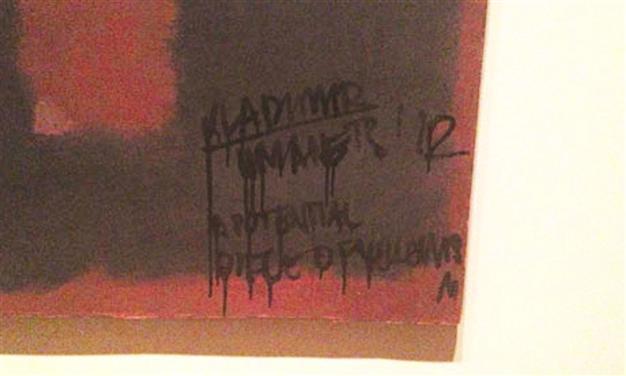Rothko mural defaced at London’s Tate Modern
LONDON

A vandal scrawled graffiti across a mural by Rothko. Mural defaced when a visitor to
the Tate applied ‘a small area of black paint with a brush to the painting,’ Tate said.
A vandal scrawled graffiti across a mural by modern American master Mark Rothko at London’s Tate Modern Museum on Oct 7.
The mural, one of Rothko’s “Seagram” series, was defaced when a visitor to the Tate applied “a small area of black paint with a brush to the painting,” the gallery said. A photograph posted on Twitter by a gallery visitor showed words, including the name Vladimir, scrawled in the corner of the painting. The gallery, which attracts 5 million visitors a year, was briefly closed on Oct. 7 after the incident.
The Tate Modern said police were investigating the incident. The graffiti on the painting also appears to read “a potential piece of yellowism.” According to an online manifesto, Yellowism is an artistic movement led by two people named Vladimir Umanets and Marcin Lodyga.
“This guy calmly walked up, took out a marker pen and tagged it. Surreal. We gave a description to the gallery. Very bizarre. He sat there for a while then just went for it and made a quick exit,” eyewitness Tim Wright said on Twitter, according to BBC.co.uk.
Mr. Wright later uploaded a picture to Twitter showing five or six words written on the bottom-right corner of the painting, and black streaks of paint running down from the daubed writing.
“The Tate can confirm that there was an incident in which a visitor defaced one of Rothko’s ‘Seagram’ murals by applying a small area of black paint with a brush to the painting,” a Tate spokesperson said.
Conservationist Julia Nagle said she had “every faith” the defaced painting could be restored.
“The first thing you need to know is what the painting was originally made of, in order to distinguish between the solubility of what you want to get rid of and the original painting. Fortunately, in the case of Rothko, there’s a massive body of research into his techniques, and there’s a great conservation department at Tate,” Nagle said, adding that the grafitti will be “much more soluble because it is newer,” meaning damage to the painting itself would be unlikely.
Russian-born Rothko immigrated to the U.S. at the age of 10, and went on to become an important post-war abstract expressionist. He was commissioned to paint the “Seagram” murals in 1958 for Manhattan’s Four Seasons restaurant, but they were never installed. Shortly before his death in 1970, he presented some of the murals to the Tate Gallery. In May, Rothko’s “Orange, Red, Yellow” was sold for $86.9 million when it went under the hammer at Christie’s in New York.
